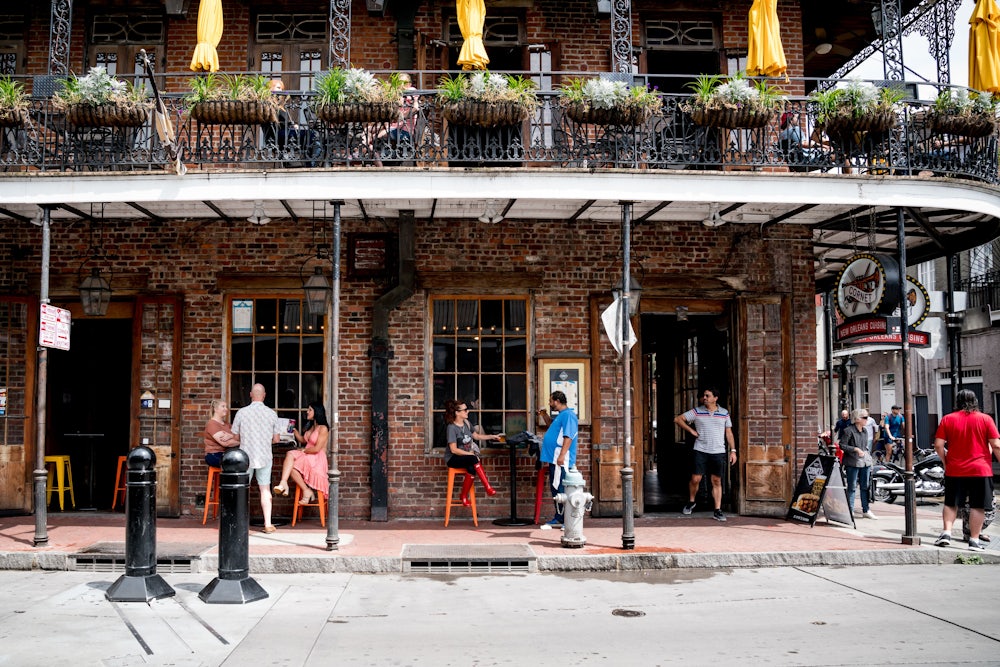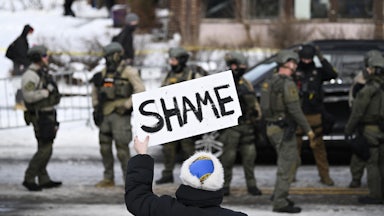New Orleans is making an ambitious bid to deliver WiFi to the homes of its poorest residents. Using “smart” electronic streetlights as nodes, it wants to establish a new citywide internet service, one that will compete with existing carriers like Cox and AT&T. The city intends to include a free tier for everyone who needs it, a group amounting to at least 16 percent of the population.
But the plan is being met with skepticism from the left. Instead of using public funds, Mayor LaToya Cantrell’s administration is proposing that tech companies cover most of the cost, which will range from $50 million to $100 million up front. In exchange, those companies would own the infrastructure, and would use it for advertising and to collect data—which they would sell, in turn, to third parties. In a city that’s become uncommonly cynical about surveillance, it’s not taken for granted that this tradeoff would be worth it.
New Orleans’s dilemma speaks to both the promise and peril of smart-city technology. This kind of infrastructure has spread rapidly over the last six years: The first LinkNYC kiosks were switched on in Manhattan, making WiFi widely available outdoors; in cities like Pittsburgh and Phoenix, smart traffic lights have reduced car congestion; and in San Diego and Spokane, the streetlights now double as air-quality monitors. In New Orleans, there are also plans to use streetlight sensors for tracking water levels so the city can respond better to hurricanes and storms. Using them to build a full internet service is a new innovation, but it’s also a logical extension of what’s been done elsewhere.
At the same time, there’s a growing awareness, both in the Crescent City and across the country, that this technology can double as surveillance equipment used by both the police and the private sector. New Orleans belongs to a small but growing list of places where grassroots resistance has taken hold, and it’s the only one where activists have so far held the technology at bay.
In general, no Southern state is more keen on privatization than Louisiana. In 2019, for instance, New Orleans became the first major U.S. city to phase out traditional public schools altogether in favor of charter schools. But in recent years, the city’s fights over police cameras have primed the population to be skeptical of more surveillance. Mitch Landrieu, who was mayor from 2010 to 2018 (and is now President Joe Biden’s senior adviser for infrastructure coordination), is largely responsible for this. In 2017, Landrieu introduced a $40-million public-safety plan that included a facility where city staff could view live cameras from all over the city. The American Civil Liberties Union described it as “surveillance on steroids.” “If you’re in the public,” Landrieu said at a news conference, “you do not have an expectation of privacy.” The mayor also tried, unsuccessfully, to force bars and liquor stores to install outdoor cameras.
In 2018, The Verge revealed that the New Orleans Police Department had been secretly working with Palantir Technologies, a Silicon Valley data-mining firm, for the previous six years. The NOPD was using Palantir’s predictive-policing software to try and identify residents most likely to commit gun crimes. As part of the arrangement, Palantir (which was created with CIA funding) was given access to millions of searchable public records, court filings, licenses, addresses, and phone numbers. Members of the city council didn’t know about the partnership until The Verge approached them for comment.
Landrieu was on his way out when this news broke, but LaToya Cantrell, his successor, has dealt with the fallout ever since. In 2019, local residents created the advocacy group Eye on Surveillance, which now acts as a watchdog against privacy incursions. When Cantrell tried to introduce a smart-city pilot program last year, installing smart streetlights in the central business district, Eye on Surveillance pressured the city council to halt the program. It ultimately worked with the council on a sweeping privacy ordinance, which was passed in December 2020. The local law clamped down on predictive policing and facial-recognition technology, though it fell far short of what the activists wanted. (A ban on license-plate readers, for instance, was stripped before the final draft.) As of 2021, New Orleans has not deployed smart streetlights or traffic lights throughout its neighborhoods—making it a relative rarity among cities of its size.
The idea for a municipal internet service seems to have broad local support. It was first floated last spring, after the pandemic forced the closing of schools and public libraries. As officials hurried to get students ready for online learning, they realized that one-fifth of local kids did not have an internet connection at home. Altogether, 27 percent of the city’s population lacks internet access—and in some census tracts, the rate is higher than 50 percent.
Cantrell’s administration decided the city needed its own solution. It seemed clear that neither the existing carriers nor the federal government was going to step in. With their budget tightened by the pandemic, Rhodes and his colleagues looked to public-private partnerships. Private companies had already been pitching them with smart-city products, Rhodes said. To navigate their options, they worked with a consulting firm called Ignite Cities, which brokers connections between municipal governments and tech companies, offering its services for free. They wanted to secure a contract that would be “cost-neutral” for city coffers.
A request for proposals went out this past spring, and the city later announced plans to work with the telecommunications firm Qualcomm and three other companies. A 240-page proposal, uploaded by the local publication The Lens, lays out how this partnership would work. The companies promise to deliver “digital equity” within two years by providing broadband coverage across a 75-square-mile area—a project that will cost roughly $50 million. However, this service would only be “directed” by the city, while the corporate contractors would operate it. The funding would come from several areas: The new streetlights would save on energy costs, and many internet users would still pay for subscriptions. The proposal also says the contractors would collect data they could monetize and share with third parties. It specifically mentions traffic data that could be sold to parts manufacturers, insurance companies, and rideshare companies. Otherwise, Rhodes said in an interview, it’s unclear at this stage what data would be involved—though he said it will absolutely not identify people individually. “We’re prohibited by law from collecting personal identifying information, so I can guarantee you that will not happen,” he said. “No one wants to get sued.”
However, Marvin Arnold, an Eye on Surveillance organizer, told The Lens last month that he still has serious concerns, because the city’s current privacy regulations don’t go far enough. “New Orleans must implement comprehensive guardrails that ensure data privacy, information security, and constitutional protections,” he told the publication, “before any major projects that risk our personal liberties are considered.”
When Rhodes spoke at a hearing last month, council members also expressed uneasiness. New Orleans City Council President Helena Moreno said she wanted to be certain that if residents sign up for the internet service, Qualcomm and its partners won’t be selling their personal data in turn. “At the end of the day, this is for public benefit, not for someone to go get really rich off the backs of the people in New Orleans,” she said. “So if it’s really going to be a public benefit, then we need ensure sure that people’s privacy is 100 percent protected.”
Privacy experts at the national level see several takeaways in New Orleans’s experience. For one, when municipal governments unveil smart-city tech, they often imply that it was their idea to start with; but in reality, much of the momentum comes from private companies, which aggressively market their products to city officials (a point Rhodes has been transparent about). Once the projects get underway, these companies mostly stay out of the public eye. “That’s the MO throughout this sector,” said Lee Tien, a senior staff attorney at the Electronic Frontier Foundation. “A lot of the work in this area will appear to the public with a government face, that then obscures the fact that there are these shadowy private companies that actually have tentacles in every single one of these cities.”
As for what data they might collect and how it could be valuable, Tien said even the tech companies may not have answers. Sometimes the business model is to collect data now and find uses for it later. As a purely hypothetical example, he said, a data scientist might look at a person’s driving patterns—perhaps using video data collected by smart traffic lights—to gauge whether she’s a likely candidate for Alzheimer’s. “Most of us who are not data scientists don’t really understand what kind of an effective telescope, or microscope, or lens that is—to be able to see more and more of what you do.”
If the kind of scrutiny being applied in New Orleans is rarely seen elsewhere, one reason is that these deals sometimes start as “freemium” arrangements—so there’s no contract for city council members to review in the first year, said Rebecca Williams, an independent tech researcher who has studied smart cities extensively. Even when local lawmakers know about the programs, the residents might not realize there’s a surveillance side, or may not see a reason for concern. It often takes “examples of real harms” to change that, Williams said. Tien also sees a racial divide that may track with attitudes toward the police. “I will be crass,” he said, “but white people often don’t get it—and people of color do.”
There has been some similar grassroots resistance in other cities. In Hong Kong, protesters cut down smart streetlights with electric saws, fearing that they might be linked with facial-recognition software. In Toronto, residents formed a coalition to stop Google’s parent company from building a 12-acre development, replete with data-mining technology, along their waterfront. (The company eventually canceled its plans, but the decision apparently had as much to do with real estate as with the outcry.) And in San Diego, 30 advocacy groups pressured the city council to regulate the police department’s use of smart streetlights for surveillance, especially after a local journalist learned the police had used streetlights to gather footage of protesters during demonstrations against police brutality. A privacy ordinance was approved in November 2020.
Most skeptics don’t even wish for a world where smart-city technology is banned altogether. New Orleans probably should have water-level sensors installed throughout the city, Williams said. But a common refrain is that they’d like to see more democratic oversight at every stage. Williams also suggested that public WiFi should instead be funded by the government itself—perhaps through tax increases or cuts from other areas, such as police departments. Moreno, the council president, said in an email that the city remains “excited” about smart-city initiatives. Her main concern is that they’re considered thoroughly beforehand. “Vendors seem eager to court the City with promises of improved efficiencies and quality of life,” she said, “but at what cost to the residents of New Orleans?”








